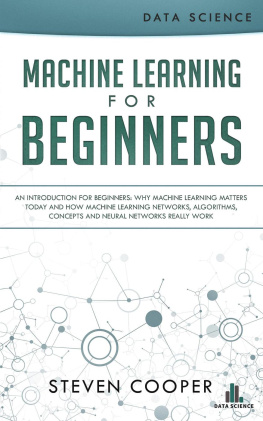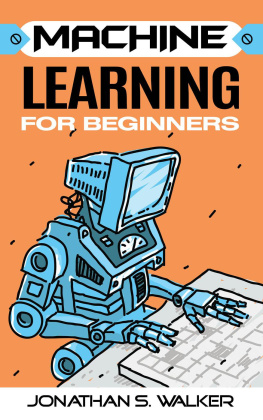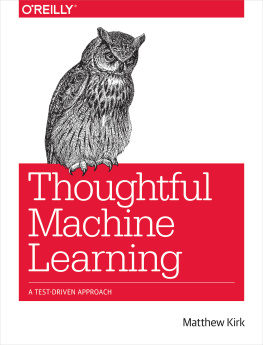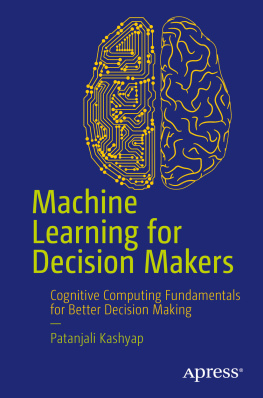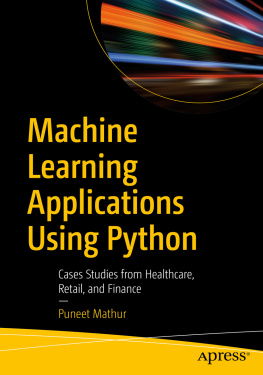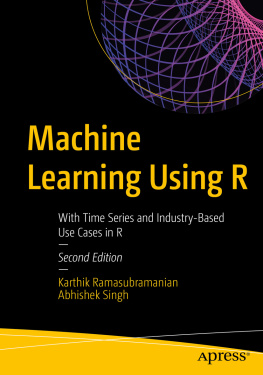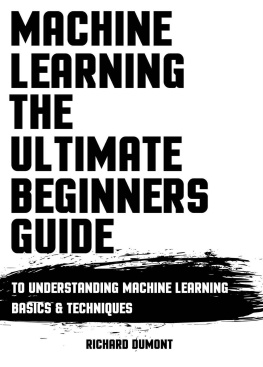Machine Learning for Beginners
The Ultimate Guide to Learn and Understand Machine Learning A Practical Approach to Master Machine Learning to Improve and Increase Business Results
Anderson Coen
Copyright 2019 - Anderson Coen - All rights reserved.
The content contained within this book may not be reproduced, duplicated or transmitted without direct written permission from the author or the publisher.
Under no circumstances will any blame or legal responsibility be held against the publisher, or author, for any damages, reparation, or monetary loss due to the information contained within this book, either directly or indirectly.
Legal Notice:
This book is copyright protected. It is only for personal use. You cannot amend, distribute, sell, use, quote or paraphrase any part, or the content within this book, without the consent of the author or publisher.
Disclaimer Notice:
Please note the information contained within this document is for educational and entertainment purposes only. All effort has been executed to present accurate, up to date, reliable, complete information. No warranties of any kind are declared or implied. Readers acknowledge that the author is not engaging in the rendering of legal, financial, medical or professional advice. The content within this book has been derived from various sources. Please consult a licensed professional before attempting any techniques outlined in this book.
Description
By reading this document, the reader agrees that under no circumstances is the author responsible for any losses, direct or indirect, that are incurred as a result of the use of information contained within this document, including, but not limited to, errors, omissions, or inaccuracies.
What is machine learning? Does it really help businesses provide better services and earn more? How can I improve my business processes to increase ROI (Return On Investment)? I am unable to focus on important tasks because I am getting bogged down by menial tasks. If you are confronted by one or more of these questions, this book is for you!
You should also get this book if you have heard machine learning but couldnt start because it looks too overwhelming. This book will demonstrate its quite easy, and many situations have similar solutions the only things needed are a bit of conceptual knowledge and some free time.
Learn machine learning and data analysis concepts through practical examples coded in Python. The following libraries are covered in great detail:
NumPy
SciPy
Sklearn (Scikit-learn)
Pandas
TensorFlow
Matplotlib
Theres also a chapter dedicated for an introduction to Raspberry Pi. If you are interested in robotics and automation, this chapter is not to be missed. Machine learning is being used in industries that are not directly related to computer science. If you are new to Python, there is also an introductory chapter that covers the basics, so you can start with data analysis and machine learning as soon as possible. Buy this book and start your machine learning journey today!
Table of Contents
Introduction
Flying without wings, breathing underwater without gills, climbing mountains, inventing cures for incurable diseases, taming elemental powers, landing on the moon, the list of human feats is never-ending. But, there is one thing that has always eluded mankind predicting the future. The biggest disadvantage humans have is never knowing when they are going to die. There is no way to predict future events with certainty. With all the technological advancements, the biggest questions are still unanswered. Will human beings ever be able to correctly predict the future?
Let me ask you a question. Did anyone in the past come close to predicting the future? How can you know without access to relevant information? The relevant information required to make a decision is generated from analyzing accumulated in the past is called data analysis. If we take the same process a little further, create trends from existing data and use them to predict future outcomes, we enter the domain called data science.
And, its not just about making decisions; for humans, its a matter of survival and growth. Every child relies heavily on data analysis to perform experiments, gather environment responses, and analyze them to learn and adapt. When a mother scolds her child because he threw the bowl across the room, he learns to not do that again. When the same mother hugs and kisses the child when the first word they say is ma, the child learns that to speak this word is happiness, and will always feel happy saying it for the rest of his life.
So, where does machine learning fits on all this? Machines are great at doing repetitive tasks, but a programmer has to write a script to tackle every possible scenario for the machine to work efficiently. What if, just like a child, the machine could learn from their experiences and experiments? Instead of telling the machine what to do for all possible situations, the machine is told a set of rules. In case an unfamiliar situation happens, the machine will determine the appropriate response using the rules and gauge the environment response. If it was favorable, the machine will record it and apply the same response in a similar situation later on. If an unfavorable response is met, the machine will use the set of rules again and start over if a similar situation happens again.
We know that real-life scenarios are much more complex than machine logics. Applying the same logic on similar situations isnt suitable when dealing with complex variables, such as humans. Consider a robot, Ms. X, who is the maid of a household. The first time she meets her charge, she tries to joke in front of the little Jana, and she bursts into laughter. Ms. X recorded this as a successful experiment and during dinner the same night and cracked the same joke. Janas older brother Jack commented, Thats the lamest joke ever. Ms. X is now confused. A human being wouldnt be confused in these circumstances; it knows a joke might be funny to one person but not for someone else. You might think this is just basic, but in fact, learning this intricacy is one of the things that sets humans at the top of the animal kingdom.
You might have seen a sci-fi movie or read a futuristic novel that talks about a hive mind. A collection of robots or machines that have come together to unlock unlimited processing power gaining abilities like future prediction, imminent threat detection, then eventually conquering and controlling the human race. Well, it might be or not be true in the future; one thing is for certain, we are moving towards fully enlightened independent robots that can thrive on their own.
The project of machine learning has one main goal to give machines the degree of learning and inference capabilities humans possess. Maybe when machines reach that level, they would be able to accurately predict the demise of humans and this planet.
I assume you have some basic knowledge about computers and programming languages before you started reading this book. Dont worry, every topic I cover in this book, I will explain right from the basics. I am also assuming you have access to a good, stable internet connection and an upgraded computer system in good condition. Data analysis and machine learning algorithms put a lot of strain on the computer resources. My Masters degree thesis was to improve an already well-optimized algorithm. The data set was huge and the algorithm was very complex. I didnt have access to a computer with a powerful configuration. I still remember how I had to leave the computer on for 20-22 hours for the program to finish processing. If you want to learn machine learning, start saving, and invest in the latest computer system.





